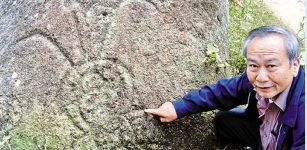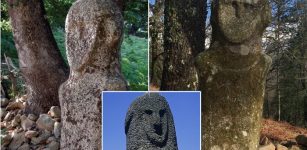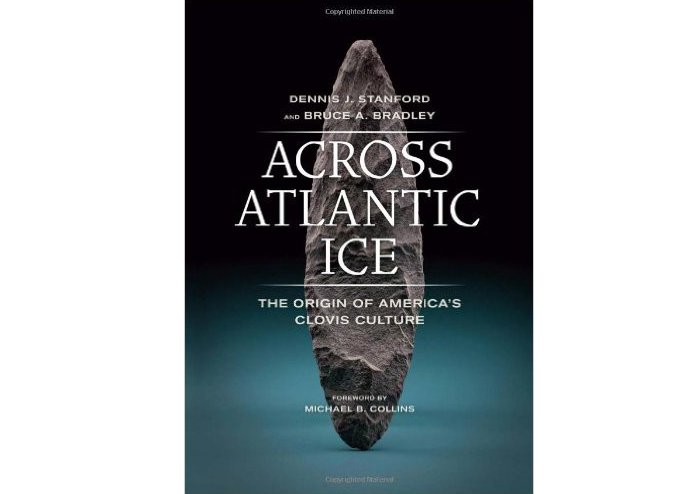Solutrean People: Were First Americans European Stone Age People?
Ellen Lloyd - AncientPages.com - Who were the first Americans? This question remains an unanswered and much-debated question. There are several promising theories, but several scientists say conclusive evidence is still missing.
Cro-Magnon artists painting in Font-de-Gaume,1920. Image: Charles R. Knigh
According to the Solutrean hypothesis, the first Americans were Stone Age Europeans who came to North America several thousand years earlier than the Ice bridge theory proposes.
The intriguing Solutrean theory raises a number of questions, such as: Where did these Europeans come from, and what happened to them? What evidence is there to support this claim?
The most widely accepted scientific theory is that sometime before 14,000 years ago, humans migrated from Siberia to Alaska using a "land bridge" that spanned the Bering Strait.
However, some scientists question the Land Bridge theory. One of them is the Smithsonian Institution anthropologist and Professor Dennis Stanford and Professor Bruce Bradley from Exeter University, who wrote the book Across Atlantic Ice: The Origin of America's Clovis Culture.
Smithsonian Institute anthropologist Dennis Stanford, left, and University of Exeter archaeologist Bruce Bradley examine knives from the last Ice Age. (Bonnie Jo Mount/Post)
Professors Stanford and Bradley believe that ancient Europeans traveled to North America across an Atlantic frozen by the Ice Age. They base their theory on stone tools discovered by archaeologists along the northeast coast of the USA.
These ancient tools are between 19,000 and 26,000 years and bear remarkable similarities to those made in Europe.
Professor Stanford said these mysterious Stone Age Europeans were known as the Solutreans, and they occupied Spain, Portugal, and southern France more than 20,000 years ago.
They paddled along an ice cap jutting into the North Atlantic and lived like Inuits, harvesting seals and seabirds.
'Ice Bridge Theory'
In time, the Solutreans spread across North America, hauling their distinctive blades with them and giving birth to the later Clovis culture, which emerged some 13,000 years ago.
According to archaeologist and paleontologist James Chatters, modern Native Americans closely resemble people of China, Korea, and Japan, but the oldest American skeletons do not. "This has led to speculation that perhaps the first Americans and Native Americans came from different homelands," Chatters said, "or migrated from Asia at different stages in their evolution."
Could these people have come from Europe?
On Chesapeake Bay islands, scientists unearthed blades, anvils, and other tools found stuck in the soil at least 20,000 years old. Professor Stanford said these ancient blades strongly resemble those found at dozens of Solutrean sites from the Stone Age in Spain and France.
The Solutreans left behind rock art, but no skeletons have been found, so unfortunately, no DNA is available to study.
Professor Stanford's theory has been met with criticism. When Professor Stanford proposed this "Solutrean hypothesis" in 1999, his colleagues rejected it. One prominent archaeologist suggested that Stanford was throwing his career away.
Who were the first humans to inhabit North America? According to the now familiar story, mammal hunters entered the continent some 12,000 years ago via a land bridge that spanned the Bering Sea. Distinctive stone tools belonging to the Clovis culture established the presence of these early New World people. But are the Clovis tools Asian in origin? Drawing from original archaeological analysis, paleoclimatic research, and genetic studies, noted archaeologists Dennis J. Stanford and Bruce A. Bradley challenge the old narrative and, in the process, counter traditional—and often subjective—approaches to archaeological testing for historical relatedness. The authors apply rigorous scholarship to a hypothesis that places the technological antecedents of Clovis in Europe and posits that the first Americans crossed the Atlantic by boat and arrived earlier than previously thought. Supplying archaeological and oceanographic evidence to support this assertion, the book dismantles the old paradigm while persuasively linking Clovis technology with the culture of the Solutrean people who occupied France and Spain more than 20,000 years ago. Read more
His theory has been revived many years later, and more scientists are curious and willing to investigate the Solutrean hypothesis further.
"The reason people don't like the Solutrean idea is the ocean," Professor Stanford said. No Solutrean boats have been found. But given that people arrived in Australia some 60,000 years ago — and they didn't walk there — wood-frame and seal-skin boats were possible, Stanford argued.
Scientists also point out that another problem with the Solutrean hypothesis is that at the end of the last ice age, the polar ice cap may not have extended all the way across the Atlantic, leaving iceberg-strewn gaps of open water for the Solutreans to navigate as they headed West for unknown reasons.
Many scientists think the Solutreans hypothesis is based on scant evidence, but it is naturally an interesting hypothesis that is worth exploring if one wants to learn more about the first Americans.
Written by - Ellen Lloyd – AncientPages.com
Updated on February 6, 2023
Copyright © AncientPages.com All rights reserved. This material may not be published, broadcast, rewritten or redistributed in whole or part without the express written permission of AncientPages.com
Expand for referencesMore From Ancient Pages
-
 Norse Goddess Sif Who Lost Her Golden Hair Due To Loki’s Evil Deed
Featured Stories | Jun 30, 2018
Norse Goddess Sif Who Lost Her Golden Hair Due To Loki’s Evil Deed
Featured Stories | Jun 30, 2018 -
 Binary Code Was Used In Ancient India And Polynesia Long Before Leibnitz Invented It
Ancient Technology | Sep 28, 2017
Binary Code Was Used In Ancient India And Polynesia Long Before Leibnitz Invented It
Ancient Technology | Sep 28, 2017 -
 4,000-Year-Old Funerary Garden Found In Luxor, Egypt
Archaeology | May 9, 2017
4,000-Year-Old Funerary Garden Found In Luxor, Egypt
Archaeology | May 9, 2017 -
 Legendary Uchchaihshravas: Divine Seven-Headed Flying Horse Of God Indra
Featured Stories | May 1, 2017
Legendary Uchchaihshravas: Divine Seven-Headed Flying Horse Of God Indra
Featured Stories | May 1, 2017 -
 DNA Study Reveals How Europe’s Hunter-Gatherers Adapted To A New Way Of Life – Farming
Archaeology | Nov 24, 2015
DNA Study Reveals How Europe’s Hunter-Gatherers Adapted To A New Way Of Life – Farming
Archaeology | Nov 24, 2015 -
 65 Byzantine-Era Tombs Unearthed In Stratonikeia – World’s Largest Marble City
Archaeology | Feb 24, 2017
65 Byzantine-Era Tombs Unearthed In Stratonikeia – World’s Largest Marble City
Archaeology | Feb 24, 2017 -
 Ancient Maya Lessons On Surviving Drought – Examined By Scientists
Archaeology | Jan 5, 2022
Ancient Maya Lessons On Surviving Drought – Examined By Scientists
Archaeology | Jan 5, 2022 -
 Extraterrestrial Visit Recorded On Stone: They Came From The Stars
Featured Stories | May 4, 2014
Extraterrestrial Visit Recorded On Stone: They Came From The Stars
Featured Stories | May 4, 2014 -
 Corsica: ‘The Island Of Statue-Menhirs’ – Where Humans Lived At Least 7,000 BC
Featured Stories | Feb 28, 2024
Corsica: ‘The Island Of Statue-Menhirs’ – Where Humans Lived At Least 7,000 BC
Featured Stories | Feb 28, 2024 -
 Ancient Recycling Technology Modern World Still Hasn’t Invented
Ancient Mysteries | May 5, 2018
Ancient Recycling Technology Modern World Still Hasn’t Invented
Ancient Mysteries | May 5, 2018 -
 Facial Reconstruction Of 3.8-Million-Year-Old Skull Shows What Our Ancestors Really Looked Like
Archaeology | Dec 29, 2022
Facial Reconstruction Of 3.8-Million-Year-Old Skull Shows What Our Ancestors Really Looked Like
Archaeology | Dec 29, 2022 -
 World’s Oldest Tattoos Discovered On Egyptian Mummies Re-Write History Of Tattoos
Archaeology | Mar 2, 2018
World’s Oldest Tattoos Discovered On Egyptian Mummies Re-Write History Of Tattoos
Archaeology | Mar 2, 2018 -
 Newport Ship: Experts Reassemble Medieval Vessel Found In The Mud
Featured Stories | Feb 7, 2023
Newport Ship: Experts Reassemble Medieval Vessel Found In The Mud
Featured Stories | Feb 7, 2023 -
 Kahina – The Prophetic Berber Queen Who Resisted The Muslim Invasions Of The Numidia Kingdom
Featured Stories | Aug 14, 2021
Kahina – The Prophetic Berber Queen Who Resisted The Muslim Invasions Of The Numidia Kingdom
Featured Stories | Aug 14, 2021 -
 Traces Of Ancient Near East Civilization In America – An Out-Of-Place Ancient Inscription – Part 2
Ancient Mysteries | Nov 13, 2020
Traces Of Ancient Near East Civilization In America – An Out-Of-Place Ancient Inscription – Part 2
Ancient Mysteries | Nov 13, 2020 -
 Varahamihira: Indian Sage And One Of The Greatest Minds Of All Time
Featured Stories | Sep 13, 2016
Varahamihira: Indian Sage And One Of The Greatest Minds Of All Time
Featured Stories | Sep 13, 2016 -
 Archaeologists Investigate The Mysterious Disappearance Of Human Skeletons In England And Wales During The 5th Century
Archaeology | Oct 16, 2024
Archaeologists Investigate The Mysterious Disappearance Of Human Skeletons In England And Wales During The 5th Century
Archaeology | Oct 16, 2024 -
 Inscription At Aquae Calidae Sheds Light On Last Years Of Ancient Thrace’s History
News | Aug 30, 2015
Inscription At Aquae Calidae Sheds Light On Last Years Of Ancient Thrace’s History
News | Aug 30, 2015 -
 28,000-Year-Old Lapedo Child: Human-Neanderthal Hybrid Reveals A Prehistoric Secret
Evolution | Mar 10, 2025
28,000-Year-Old Lapedo Child: Human-Neanderthal Hybrid Reveals A Prehistoric Secret
Evolution | Mar 10, 2025 -
 Picts: Facts And History About Mysterious People Of Northern Scotland
Civilizations | Feb 2, 2016
Picts: Facts And History About Mysterious People Of Northern Scotland
Civilizations | Feb 2, 2016




